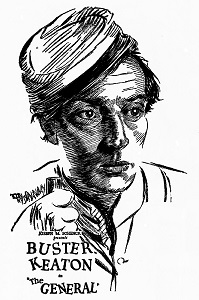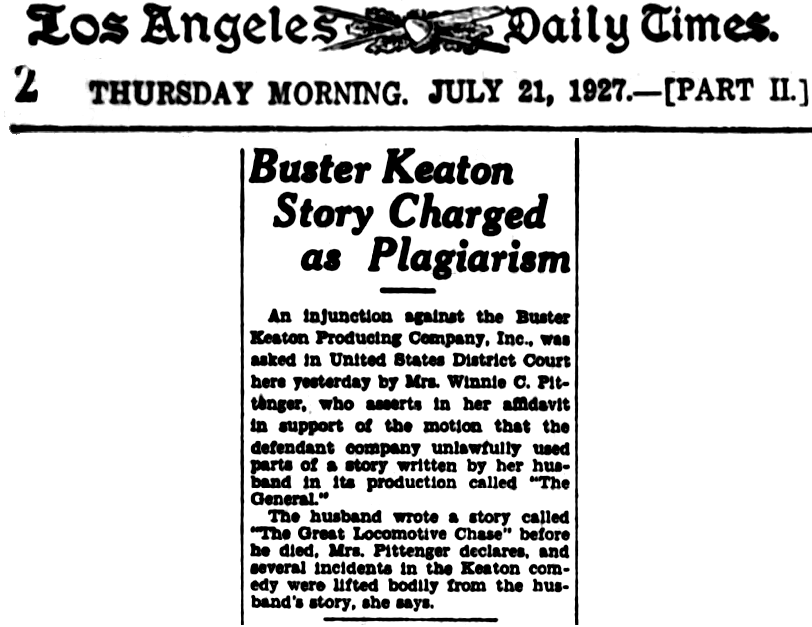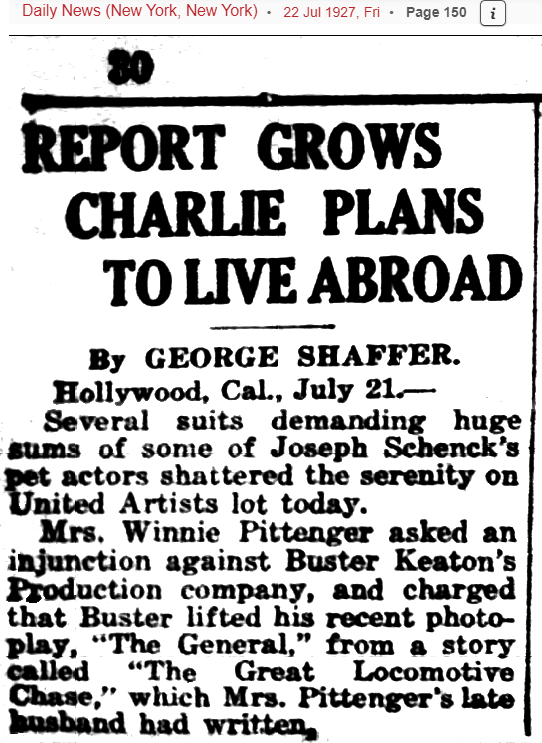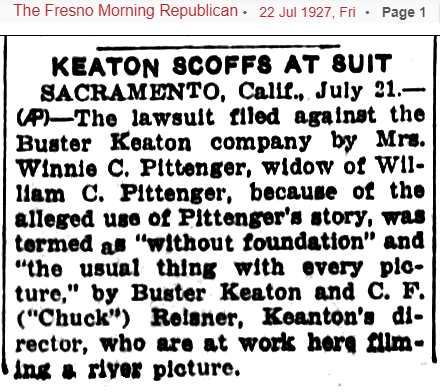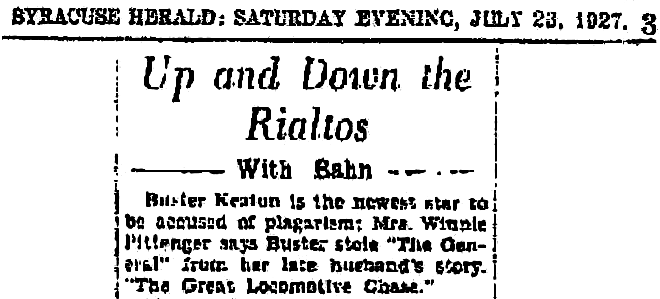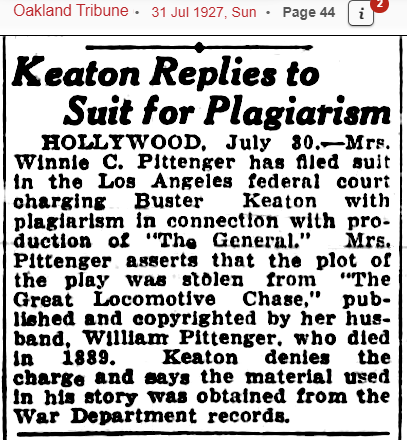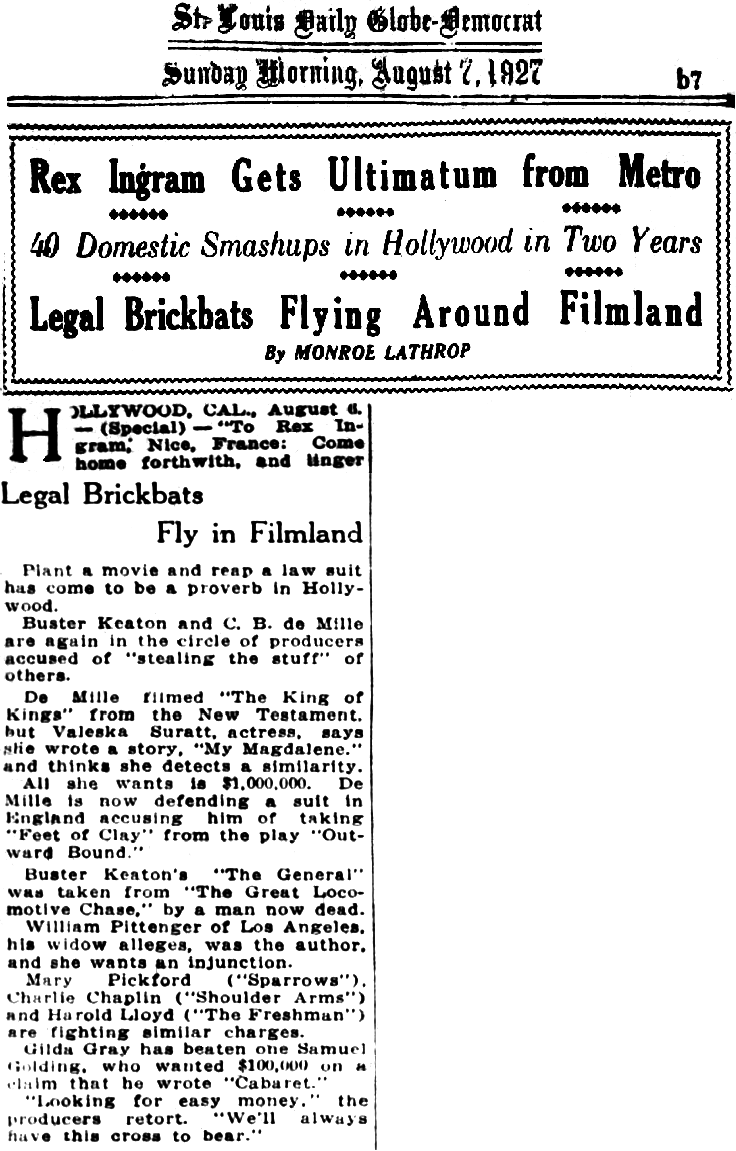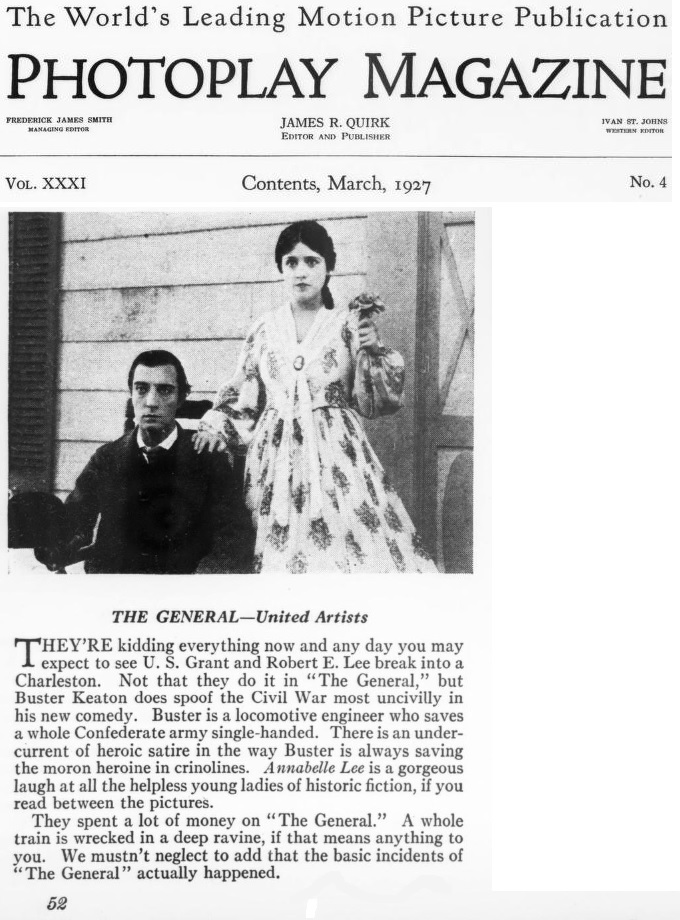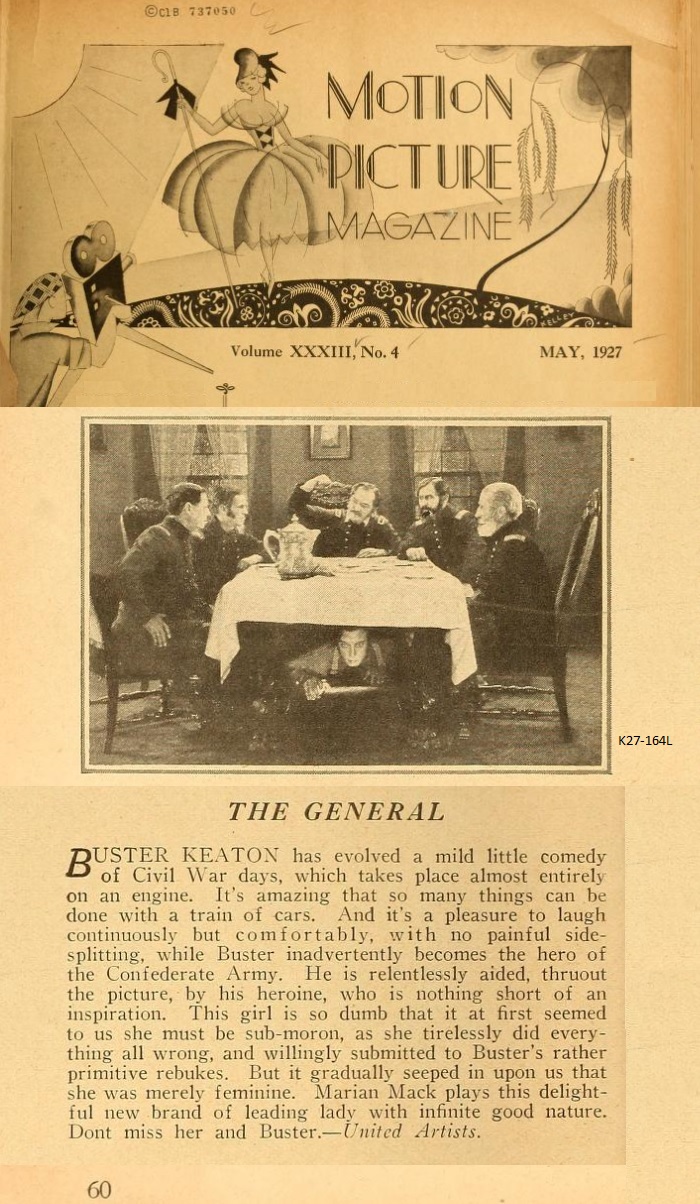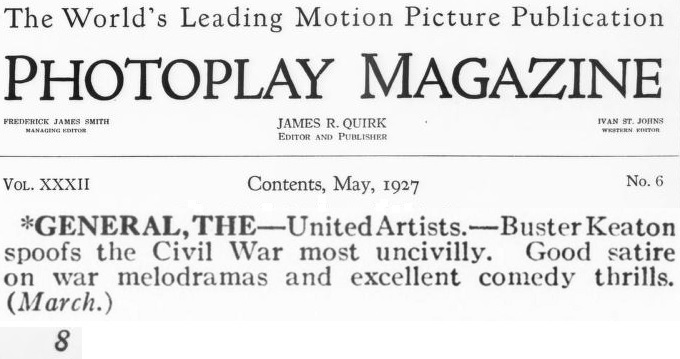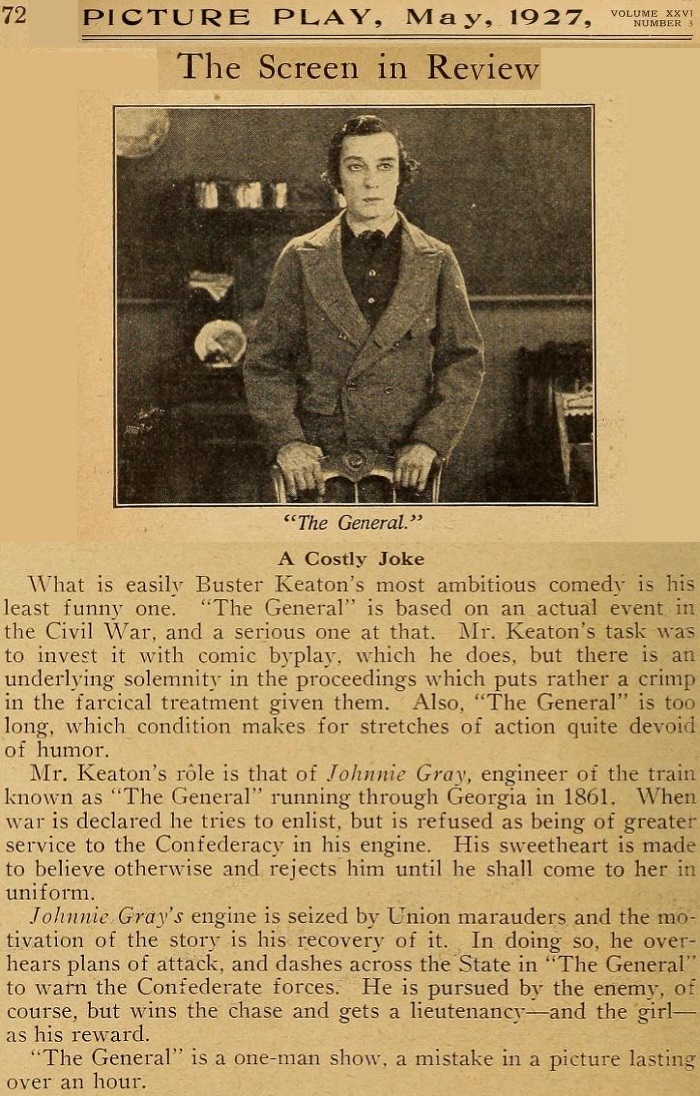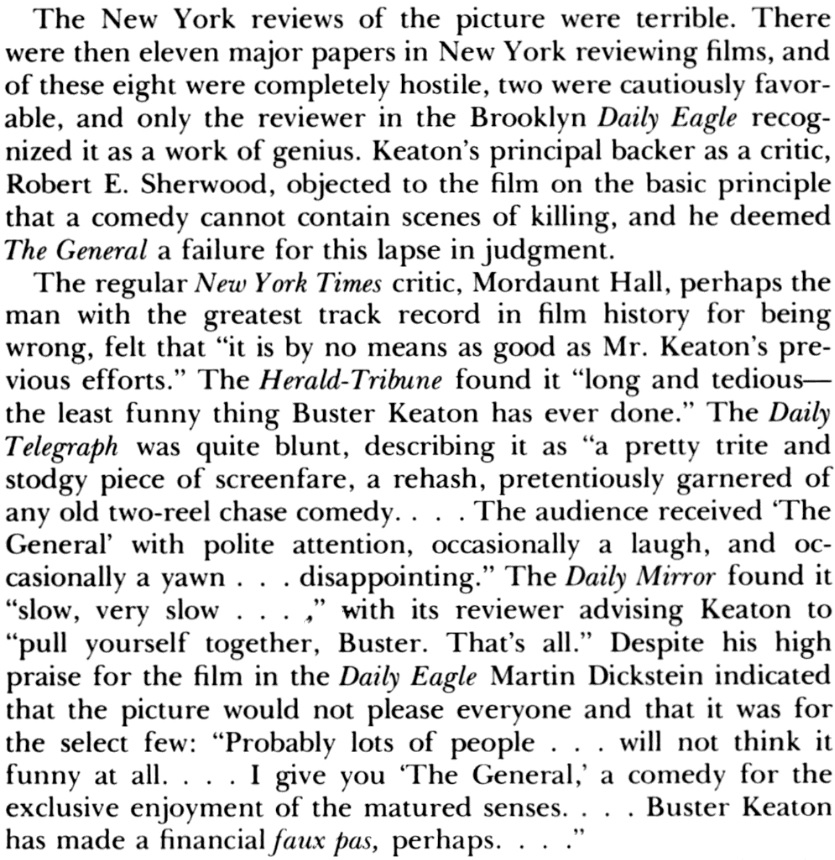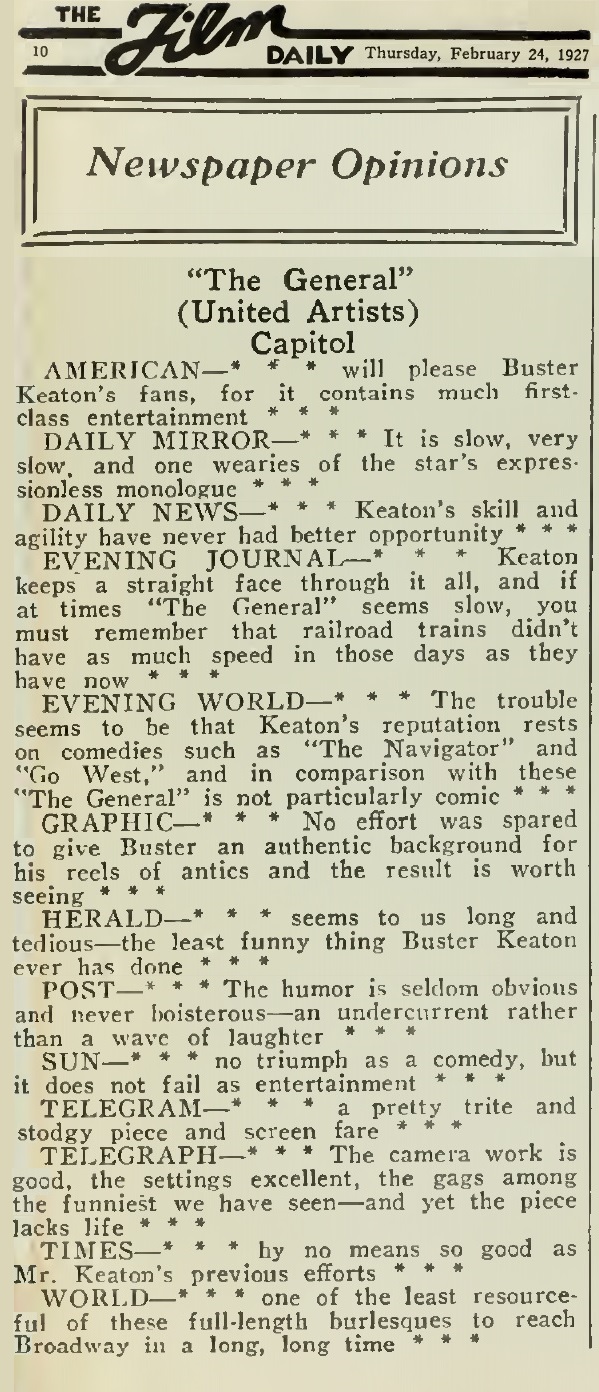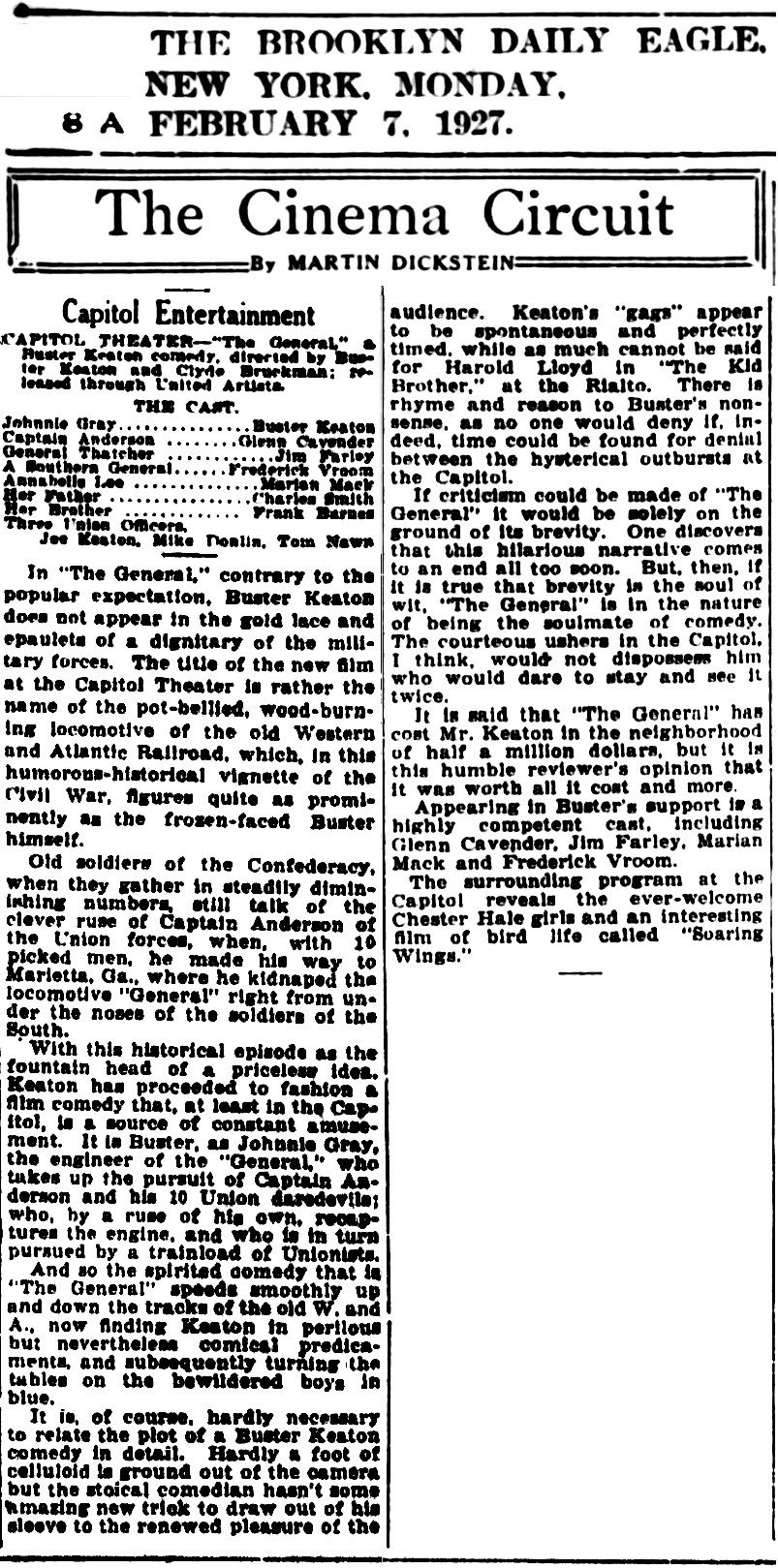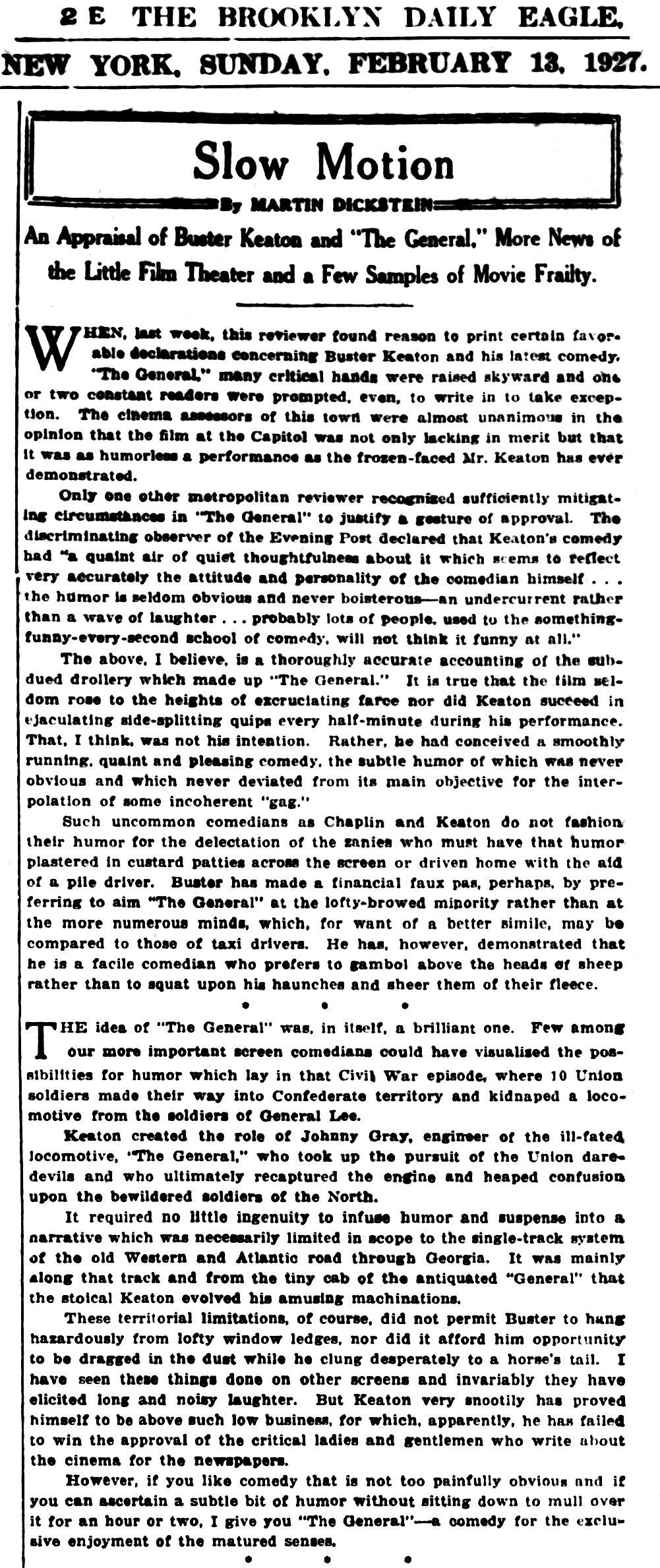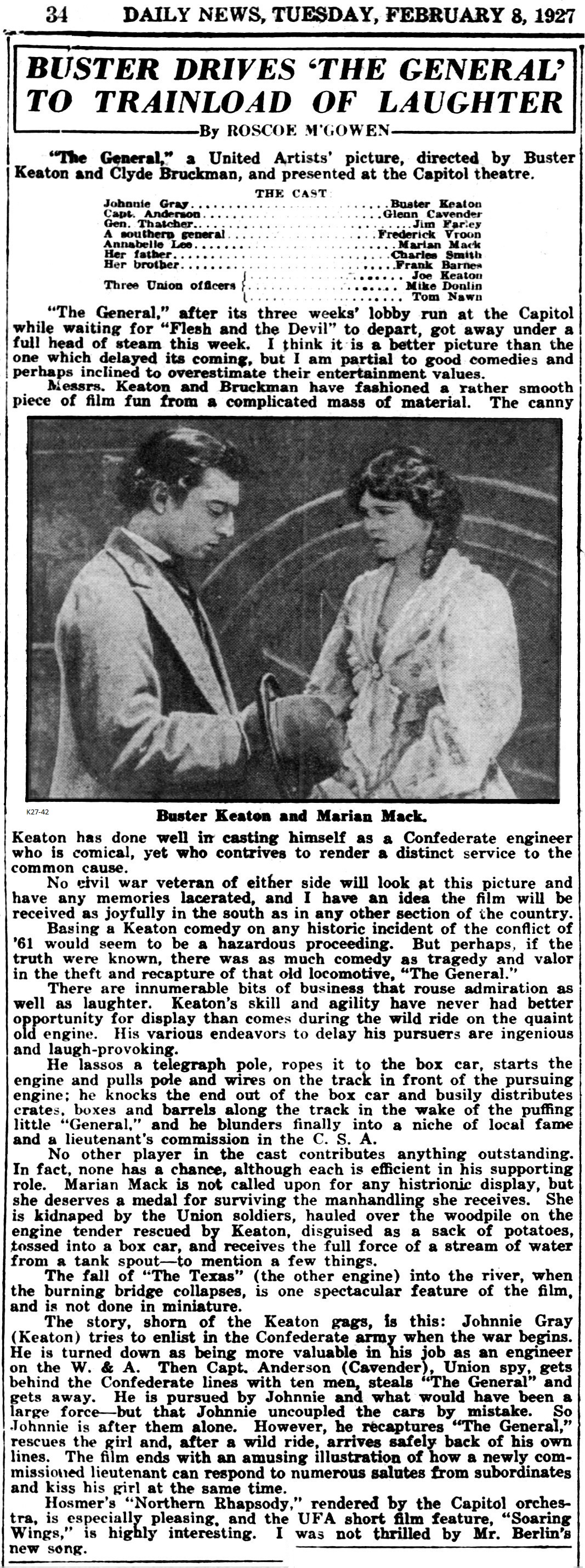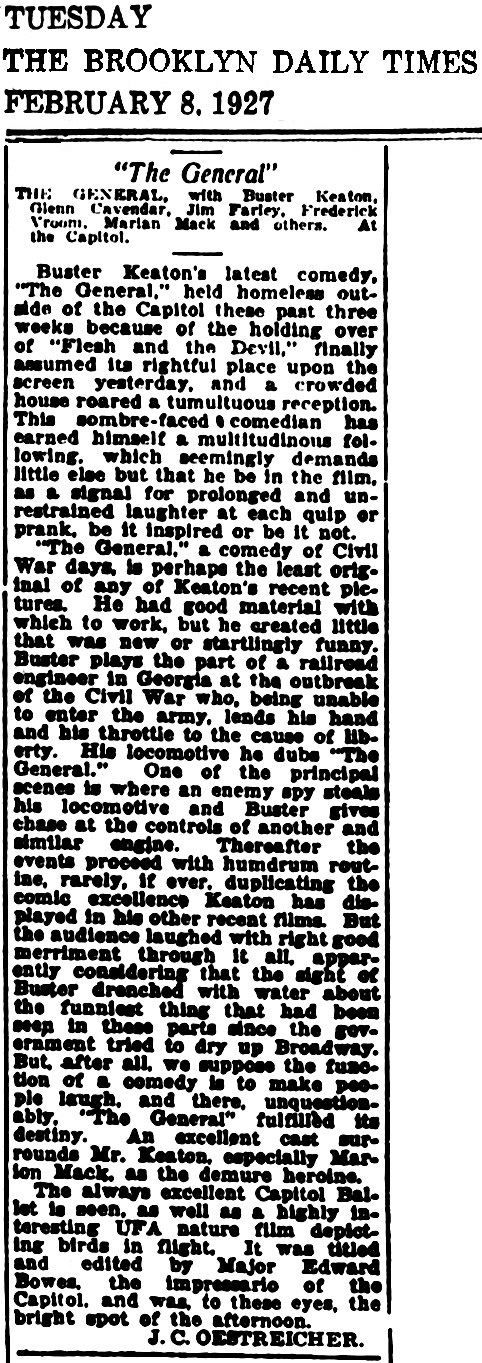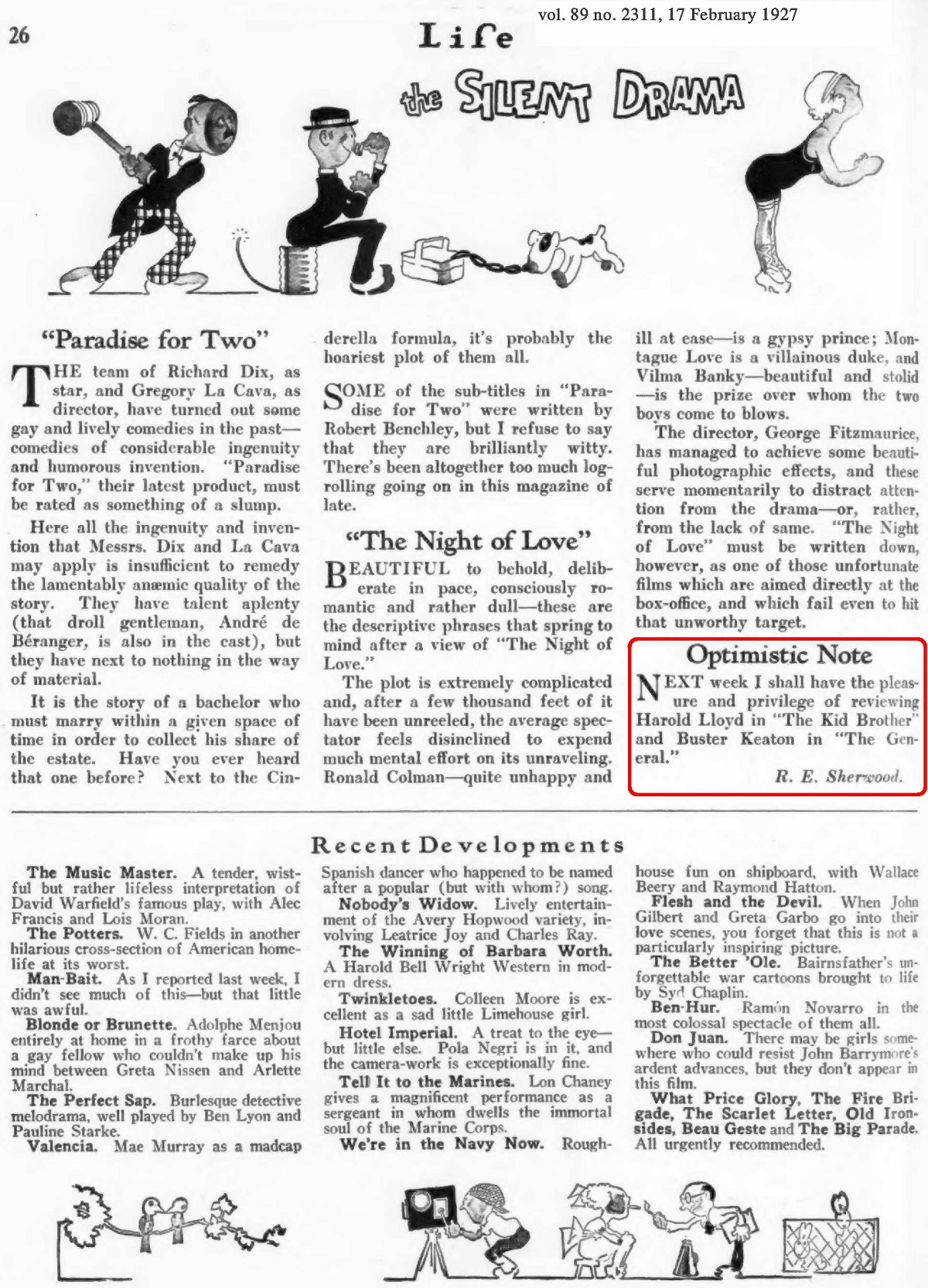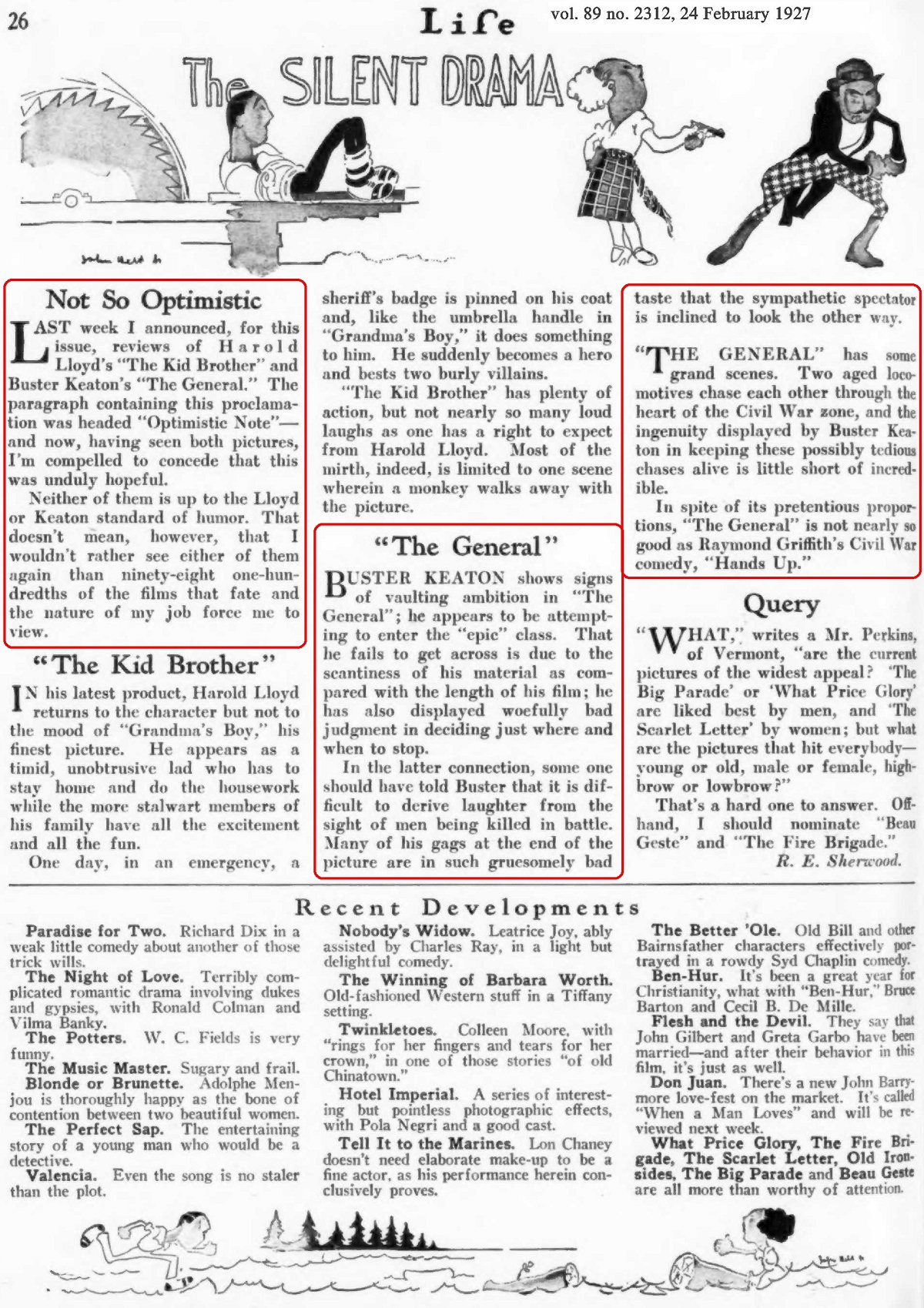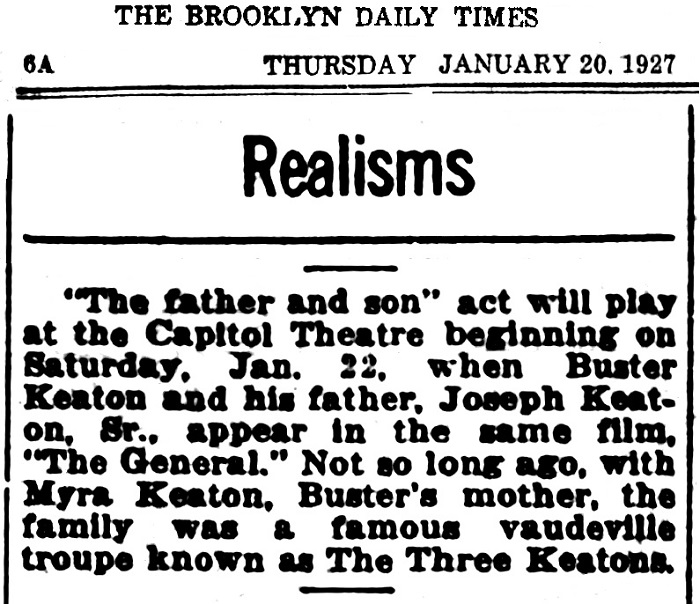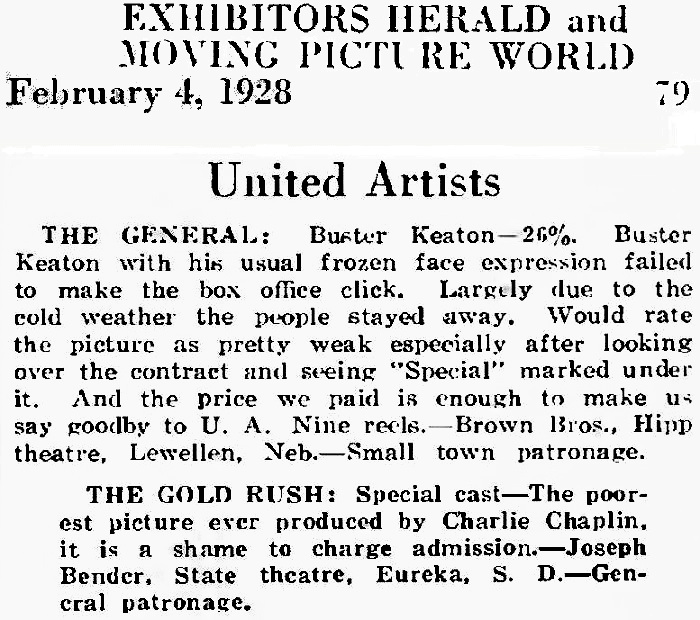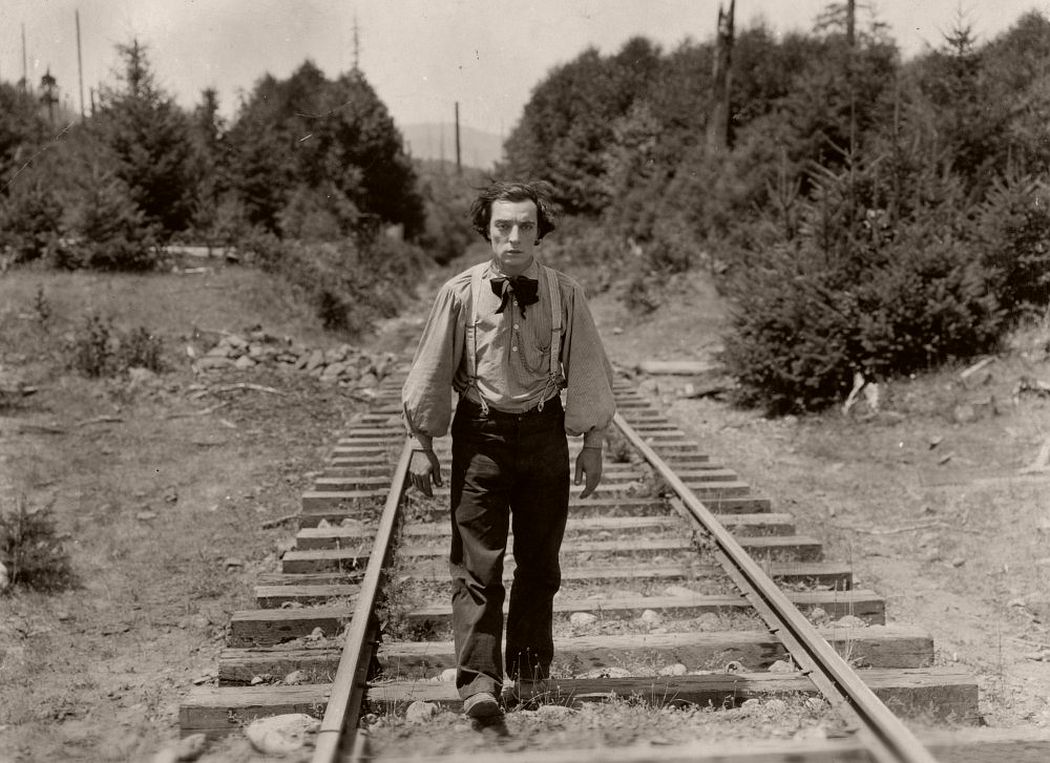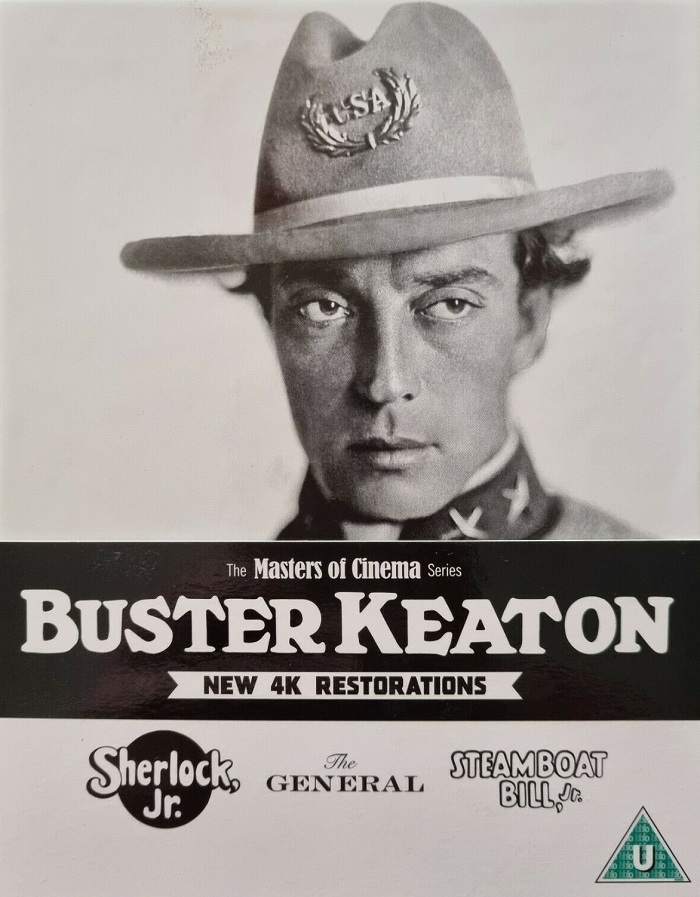The Legal Challenge
from Winnie Pittenger
This happens with probably every successful movie.
It is not plagiarism to be inspired by a book to create your own original work of fiction, provided your work truly is original,
which The General most definitely was.
It is not plagiarism to borrow from real life.
Plagiary suits are not, to my knowledge, filed against box-office failures.
If a movie is a commercial success, though, the plagiary suits inevitably start flowing in.
It’s a law of physics.
I hesitate to rush to too much judgment, though, because I would first love to get Winnie Pittenger’s side of the story.
Did she really feel aggrieved? Or did she just need some dough?
That seems to be the end of the news stories.
I guess I can guess that the suit fizzled for lack of substance.
The Reception
Few newspapers in those days published movie reviews.
What they published were stories from the press books, which many people thought (and many probably still think) were reviews.
They were not; they were publicity.
For actual reviews, one had to go to the fan mags.
In the winter 2001[/2002] issue of
The Buster Bulletin,
David Macleod went through reviews in popular movie magazines that the general public would likely have seen.
|
Excellent comedy for 1st class houses.
It cannot fail to please a discriminating audience.
Buster Keaton gives a performance of polished comedy.
|
|
Buster Keaton has taken unto himself the task of filming the Civil War from the vantage-point of an engineer’s cab.
He does it to the time of burlesque — that is devoid of the customary amount of Keaton comedy.
“The General” is not so amusing as I anticipated.
Buster found his inspiration in an actual incident of the Civil War — the Andrews railroad raid at Big Shanty, Georgia.
It is a pleasant piece of celluloid without any rollicking moments.
The picture gets its title from the engine — one of those old-fashioned contrivances.
And with Buster at the throttle, it becomes involved in a chase — chase to the North and later to the South.
The Union forces are routed, and the sad-faced engineer wins the girl.
There’s a quaintness about the atmosphere — which is in perfect harmony with the plot.
It is quiet, somewhat bucolic — and Buster, in his make-up, looks like some old-timer in the plush-covered album.
|
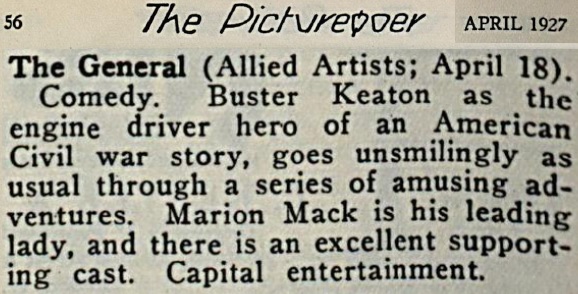
|
“Brief Reviews of Current Pictures,”
Photoplay (May 1927):
Picture Play (May 1927):
Norbert Lusk gave it a negative review,
perhaps unique among contemporary fan magazines:
Revisionism:
Cherry Picking the Evidence
Buster Keaton said that The General was one of his three top financial successes.
And check out the lovely interview with
Marion Mack:
“...we were surprised when it took off as it did.
It was the audiences that made it such a hit;
the studio never realized what a gem they had in their hands until the money started rolling in.”
This was commonly accepted knowledge, and nobody thought to question or investigate what Buster and Marion had said.
Well, nobody — until Tom Dardis came along.
Tom Dardis’s mistake-ridden 1979 “biography,”
Keaton: The Man Who Wouldn’t Lie Down, shook movie scholarship to the ground.
He brought forth evidence that The General had been met with critical hostility
and that it had been a massive flop that would soon cost Buster his freedom.
He cited as evidence of The General’s poor reception
snippets from five reviews from New York City newspapers,
which were among the few newspapers that had movie critics on the payroll
(p. 144):
That, Dardis implied, was pretty much the sum total of critical and popular opinion.
Courtesy of online newspaper archives, I am now able to trace two of these five reviews,
and why am I not surprised to discover that Mordaunt Hall’s negative review is not quite so awful as Dardis makes out?
Why am I not surprised to discover that Martin Dickstein’s comments
are not exactly what Dardis attributed to him?
Why did Dardis not quote from reviews from elsewhere in the country?
As we witnessed above, most reviews outside NYC were quite flattering.
Heck, why didn’t he quote from other NYC newspapers?
He could have, and he should have, and you’ll see those other reviews below.
Basic rule: With but a single exception, if a review was favorable, Dardis ignored it.
If a review mentioned how much the audience enjoyed the movie, Dardis ignored it.
This is how history is done.
This is no different from the way history is taught in schools.
Sources are selectively quoted or even misquoted, while other sources that present different evidence are ignored.
The history we read in books is all balderdash.
Where did Dardis get that idea?
Did he actually believe what he wrote?
To the second question, the answer is “No,” at least not at first.
It is possible that he later came to believe his own deception.
To the first question, we also know the answer.
Actually, to the first question, we know both answers.
I shouldn’t say that.
We know all THREE answers.
The joyous tedium of doing research reveals what the “authorities” had discovered before you got there;
you discover the sources that they accidentally-on-purpose neglected to footnote.
Here is what I just discovered on Monday, 21 November 2022.
We saw this above, but let’s look at it again:
The Film Daily was a trade publication out of NYC,
and it included snippets of the local NYC reviews.
This is what Dardis found.
He probably visited the library to grab the original reviews from the microfilms and maybe see if he could find one or two more, and he did.
He found
The Brooklyn Daily Eagle.
He quoted
The New York Daily Telegram
but wrongly ascribed the quote to
The Daily Telegraph.
He also quoted
The New York Herald-Tribune,
The New York Times, and
The New York Daily Mirror.
He skipped
The New York American,
the Daily News,
The New York Evening Graphic,
The New York Evening Journal,
The New York Evening World,
The New York Evening Post,
The New York Morning Telegraph,
The Sun, and
The World,
surely because most were less than entirely hostile and because some were even positive.
The Film Daily itself skipped
The Brooklyn Daily Times,
and so Dardis skipped that one as well.
Dardis pulled the snippets that served his purpose and he skipped the ones that didn’t.
Now I know Dardis’s first source, and now that I know his first source, you know it too!
Dardis wrote that NYC had eleven major papers that ran regular movie reviews.
The Film Daily quotes from thirteen NYC reviews.
So, which all were “major” and which all were not? I do not know. Do you?
|
A Plea for Help
Can you find the reviews of The General from the following (all circa Monday, 7 February 1927)?
The New York American
The New York Evening Graphic The New York Herald-Tribune The New York Evening Journal The New York Daily Mirror The New York World The New York Evening World The Sun The Evening Telegram The Morning Telegraph
If you find reviews in these or other publications, please send them along!
Many thanks!
|
Dardis’s second source was Louise Brooks.
Are you familiar with Louise Brooks?
If you’re not, you should be. I remember
Christmas Eve 1977, when Jim Card’s preliminary restoration of
Pandora’s Box
was broadcast on PBS, properly transferred at 20fps (75'/min), accompanied by
Bill
Perry’s seductively hypnotic piano score,
which, unfortunately, was never heard in public again.
(It was by leaps and bounds the finest score I have ever heard for that movie.
I’m lucky to have gotten a copy, transferred from the quad just before it gave up the ghost,
but my lucky copy, alas, is currently in storage; I must retrieve it.)
I was mesmerized by the movie.
The movie just knocked me away; it was easily one of the finest works of cinema ever made.
Louise Brooks was a name I knew but the name was all I knew, until that night.
She was magnificent.
She knew the secret of acting: Don’t!
She put little or nothing into her performance and just let her part tell itself.
Her underacting was easily one of the finest performing jobs I have seen, ever.
Beyond that, she was knee-weakeningly , breathtakingly, eye-poppingly , jaw-droppingly gorgeous,
with gigantic eyes that were spookily similar to Buster’s.
I was so bedazzled I could hardly breathe.
I didn’t want the movie to end, ever, mostly because I never wanted to stop gazing at her.
Then, to my chagrin, I learned about her.
It was in
April 1990 that Diane Christian, Jim Card, Barry Paris, and Phil Carli presented a mini retrospective of Louis’s better movies
over the course of a Saturday and Sunday at the ugly Knox auditorium attached to the sumptuous Albright Art Gallery in Buffalo.
Barry told about his research into her life.
Jim told about his liaisons with Louise.
What I heard was too familiar to me.
I had experienced all these behaviors, exactly, which is why I was one step ahead of each story.
Louise definitely had some sort of personality disorder.
Jim told the story of visiting Germany with Louise.
While they were strolling down the street, Louise excused herself for a few minutes and Jim waited on the sidewalk for her.
Just then, he saw Fritz Kortner coming along.
Fritz had been Louise’s costar in Pandora’s Box.
Jim was overjoyed.
“Mr. Kortner! You won’t believe this, but I’m here with Louise Brooks,
and she’ll be back here in just a few moments.
Please wait around, because I’m sure she’d love to see you again.”
Fritz’s eyes grew wide in terror and he immediately ran away as fast as he could.
Yup.
That would have been precisely my reaction, too, concerning someone whose personality was a Xerox copy of Louise’s.
I understood. Perfectly.
All my illusions were shattered to pieces.
Louise was a depressive, self-destructive drunk, a manipulative nag with a temper.
Besides which she was just plain old nuts.
Intelligent? Absolutely! But nuts.
Oh well.
I’d rather know the truth than live in a fantasy.
I also learned not to take seriously anything she said.
She knew Buster a little bit, though how little I’m not too sure.
Probably very little. Very very little.
Maybe they were introduced at a gathering and said Hi and that was it,
except for maybe one or two later times when they bumped into each other and said Hi and nothing more.
Apparently Louise penned a letter to Buster, waxing lyrical about his supine face
(apparently the shot of him hiding under the table half-way through The General).
They probably never spoke more than a few words to one another.
To Dardis, Louise insisted that “Buster was very sexy, very relaxed and easy with women,
the first sign of a man secure in his performance.”
Yeah, right, sure, whatever.
That was as far from the truth as could be.
That was from a letter dated 26 October 1977.
She also told
anecdotes about Buster, but I have no reason to believe them.
(Barry Paris is convinced those anecdotes are true. Maybe he’s right.)
She had
a false story about his death, too.
So, in brief, she was not a reliable source, unfortunately, because she was a colorful, well-spoken, copious source.
It is so tempting to believe her, to hang on her every word. Oh well.
She lied.
We hear her stories and so we are convinced that we have the inside scoop.
We do not like to admit to ourselves that someone we admire lied through her teeth.
We do not like to admit to ourselves that we fell for it all.
I sure don’t like to admit it.
But she lied and I fell for it all.
Now, Aunt Louise wrote a letter to Kevin Brownlow, dated 23 November 1968,
and everybody takes this letter seriously.
Everybody except for me.
|
It was the title, The General. We thought Buster was playing a general, a
Southern general. Not funny. As an Englishman, you cannot understand that the Civil
War killed thousands of Americans fighting against their own families, almost
wrecking our country. Nobody connected The General with the name of an engine.
Many people stayed away. Those who saw The General were puzzled.
|
Oh dear dear Aunt Louise.
Love ya, Aunt Louise, but really now.
She was an eyewitness, in the know, who convincingly but wrongly claimed to have been in the inner circle,
an insider who seemed to know everybody and everything.
Everybody took her seriously,
but she had no idea what she was jabbering on about,
and the less she knew the more she jabbered.
Her jabbering, seemingly so innocuous, resulted in a cascade of problems,
as serious researchers attempted to square her stories with reality.
When evidence and Aunt Louise disagreed, it was Aunt Louise who invariably prevailed —
probably only because it’s so tempting to believe
such a marvelously eloquent raconteur who was an eyewitness and who was so darned entertaining.
Dardis fell for her tales hook, line, and sinker.
Either that or he pretended to.
One way or the other, he published her stories as though they were the definitive truth.
Dardis also got his idea from another source, a good, respectable, respected source:
George Wead.
George is a good guy and a good researcher.
I met him, though I am sure he wouldn’t remember me.
He wrote “The Great Locomotive Chase” for
American Film: Journal of the Film and Television Arts, vol. 2 no. 9, July/August 1977, pp. 18–24.
For the most part, it’s an exceptionally good article, with info that had never been published before.
Yet he opened his good article with an uncharacteristically bad summary:
“The nation’s major film reviewers wrote off The General as an extravagant mistake....
Others dismissed the film more quietly.”
Now, where, pray tell, did George get that idea?
Why did he choose quotations so selectively?
Did he, perchance, see that summary in The Film Daily?
No. I’m sure he didn’t, at least not at first.
What I bet happened is that George, aware that some guy named Dardis was working on a new biography,
wrote to the author to ask for some representative reviews.
And guess what Dardis sent him.
Therein lies one of the common pitfalls of scholarship.
It is a pit into which we have all fallen too many times.
If my intuition is correct, and I bet it is:
Dardis faked it,
George copied Dardis,
and then Dardis copied George’s copy of Dardis.
Each pointed to the other as confirmation.
Just like college professors, yes?
Dardis latched on to the idea of critical objection to The General and then he piled on,
and when he piled on, he chose his facts most selectively.
What little evidence seemed to support Louise, George, and Film Daily, he quoted gleefully.
The mountains of evidence that contradicted Louise, George, and Film Daily,
well, he didn’t find that of any interest and so he left it all out.
Small beer, isn’t it?
A nonacademic scribbler publishes a popular book without peer review
and lies about what movie critics wrote half a century before.
Big deal, right?
We have many more important things to worry about, yes?
Well, there really is a problem here, and a huge one.
That tiny little irrelevant lie had an effect that reverberated across the whole book,
and it distorted the entire “biography.”
The so-called biography, the first unauthorized biography of Buster,
set the standard for everything that would follow.
Dardis was confident that nobody would ever check his work,
and he was right, nobody ever checked his work —
until I came along, and my credentials are nonexistent.
I am not a recognized scholar with a position in academia and a long list of well-reviewed university publications behind me.
Sorry. I’m just a nobody and my website carries no weight.
Still, though, my web essay is infinitely more accurate than Dardis’s volume.
Dardis contaminated the record.
Countless academicians and scholars and biographers and writers and encyclopedists believed everything that Dardis wrote,
and some reviewers went so far as to proclaim Dardis’s “biography” the best yet written.
But what Dardis wrote was not a biography.
It was fiction, it was defamation of character, and his allegations were all wrong,
his research was flimsy at best and he lied through his teeth.
When we allow one author to get away with this, we open the floodgates for even worse, in all fields of research.
And that, unfortunately, is exactly what happened.
Dardis had a golden opportunity to do proper research and to establish a better record.
He entirely squandered that opportunity and unleashed a piece of rot in its stead.
Since the publication of Dardis’s book in 1979,
countless cinema historians, Buster biographers, critics, and commentators
have repeated the brief quotations that he supplied in that short passage reproduced above.
Do web searches on those five direct quotes and you will find them all over the place, verbatim, with ellipses in the same places.
To the best of my knowledge, no researcher has tried to replicate his research.
Whenever I attempt to duplicate a scholar’s research, I get radically different results.
That is certainly the case here.
Be patient and read through what I discovered.
At first, you will find that my objections are strained nuances, pointless nitpicks.
Keep on reading.
Pretty soon, you will find that much of the evidence is the reverse of what Dardis claimed.
I invite you to continue this project.
Visit your libraries, find the reviews in your home town,
and, if the information by some miracle is still available,
dig up the data on the ticket sales and box-office revenues and compare them to the house averages.
See what happens, and
please tell me what you discover.
This much I can assure you even now:
In most cow towns, it flopped; but in most other localities, The General performed nicely.
The few newspapers that offered reviews mostly reviewed it nicely.
In the US, The General was not a major hit, but it was a reasonable success overall.
Here is
Mordaunt Hall’s full review, not much different from what Dardis implied, but slightly different,
and that slight difference makes a difference:

For the life of me, I have not the foggiest notion what “a mixture of cast iron and jelly” means.
It is clear that Mordaunt Hall misunderstood the movie, and that is hardly surprising.
It’s not his cup of tea, and that’s fine, but he did mention that the audience were laughing.
Dardis wrote that Hall’s review was negative, and, yes, he was right, it’s pretty negative.
The point I wish to make is that Dardis characterized Hall’s review as “completely hostile.”
As you can see, it is not.
It is not a favorable review, but it is by no means “completely hostile.”
Am I nitpicking?
Yeah, maybe.
By the way, only just now do I notice the point that Mordaunt Hall was making.
His objection was that Buster was not so much a clown in this movie.
Correct.
Buster played it straight, entirely straight.
Mordaunt preferred to see clowning.
Buster had clowned around in his short films, but not so much in his features, and there was a reason.
A short film can be jokey, cartoony, silly, implausible, improbable, impossible.
Once a movie is much more than about 15 or 20 minutes, though, such jokiness gets to be tiresome.
A longer story needs to be plausible; it needs to have a structure that would stand on its own even minus the comic elements.
There are exceptions.
The Cocoanuts, or what little is left of that butchered movie, got away with feature-length silliness and clowning — well, mostly.
The same holds true for
Monty Python and the Holy Grail — well, mostly.
Zazie dans le métro also got away with it — well, mostly.
Those are the rare exceptions that prove that horsing around can be done nonstop for a good 90 minutes without wearying the audience too much.
Those are rare exceptions.
There may be a couple of others.
Some people might say that
Airplane! was another example.
Buster couldn’t think of a way to clown around for an hour or more and get away with it.
Charlie Chaplin couldn’t think of a way to do that either.
Neither could Harold Lloyd.
Not even Laurel & Hardy could work it out.
Once they made movies that ran much more than 20 minutes, they all cut down on the clowning, a lot, and they beefed up the stories, too, a lot.
The characters and the situations had to be credible, or somewhat credible, else there would be nothing to hold the story together.
As a rule, clowning is good only in small doses, very small doses.
As you read some of the other negative reviews, you will find that
a minority of critics made it clear that they wanted to see silly horseplay, pie throwing,
clumsy nincompoops falling into mud puddles and slipping on banana peels,
and not straight comedy in a plausible story.
Let’s get back to my nitpicking.
Here is Martin Dickstein’s actual review.
Dardis claimed that this review recognized The General “as a work of genius.”
A work of genius?
Dickstein implied no such thing.
He wrote that it was an exceptionally fine film, not “a work of genius,” please.
I hate such exaggerations.
It’s instructive to read the review in its totality:
